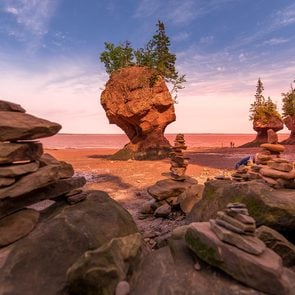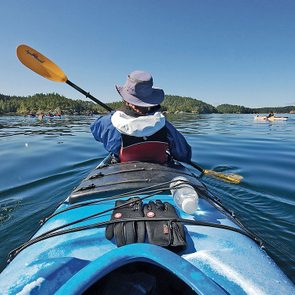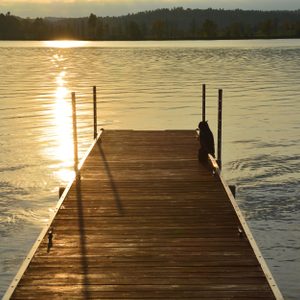When Louise Bardswich helped her mother move into a retirement residence in 2012, she realized she’d never want to live in one herself. The lifestyle—scheduled meals and activities, sharing space with strangers—didn’t appeal to her, nor did the price tag. Depending on the extent of care she might need one day, a spot in a seniors’ home could end up costing her between $2,000 and $6,000 a month on average, which would quickly eat up the money she’d saved working as a college administrator in Toronto and, later, as a management consultant in Port Perry, Ontario. “I thought of myself 20 years out, did the calculations and realized it wasn’t in the cards,” says Bardswich, who was widowed and in her early 60s at the time. “I was not going to be able to afford that.”
She shared her worries with her friend and former colleague Martha Casson, who was in her 60s, divorced and living with her elderly mother. Together, they began researching alternatives to typical old-age living and found examples, both locally and internationally, of seniors moving in and aging together. It seemed cheaper and more independent than a retirement home, and safer and more social than living alone. So, they asked themselves, why not give it a try? “The reality is that, in many cases, we’re going to be living with someone else anyway,” says Casson. “But if it’s 100 other people in a retirement home, we’re not picking those people or controlling our lives.”
Soon after, the women shared their findings with Beverly Brown—a friend from Bardswich’s curling club. She loved the idea and thought her friend Sandy McCully would, too. Brown, who was divorced, and McCully, who was widowed, were retired from nursing and wondering what to do with their empty, too-big suburban houses. Like Bardswich and Casson, they were among the 91 per cent of Ontario seniors who, according to a 2020 survey conducted for Home Care Ontario, wanted to age in their own home, not an institution. They also didn’t want to burden their families, calling their children every time they needed the lawn mowed or driveway shovelled. As McCully puts it, “My two boys aren’t into, quote, ‘this caregiving thing.’”
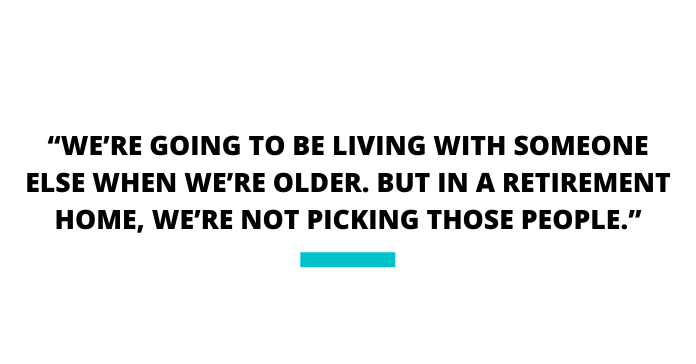
By 2016, the women had decided to sell their homes, and each chip in $275,000 to buy and renovate a two-storey, nearly 5,000-square-foot house in Port Perry. It felt like a good deal. The renovations included outfitting their new home with a wide porch and fresh vinyl siding. They were confident they’d get a return on their investment; the money they’d put into the house would grow and be inherited, not wither away paying for assisted living.
Plus, the location was great: the house is close to grocery stores, and the lakeside town of 10,000 is about an hour’s drive northeast of Toronto, with a picturesque Victorian-era downtown and plenty of retirees. The house even comes with a personal connection: Brown’s great-great-grandfather had helped build it in 1855. The women planned to share the kitchen and living room, but each would have a private suite with a bedroom, sitting area and accessible bathroom.
Before they moved in, the four women drafted and signed a lengthy legal agreement to solidify the details of their co-living arrangement. They’d each pay $1,700 a month to cover property taxes, home insurance, utilities, Internet, cable, maintenance, snow removal, weekly cleaning services and the cost of food and wine, both of which they share freely. The agreement also stipulated what would happen if one of them left the house (the other women could buy her out, or she could sell her share to an agreed-upon buyer). Later on, they also discussed what would happen if someone got a boyfriend (this would be okay, so long as everyone liked him and he helped around the house).
When they arrived in November 2016, the Golden Girls of Port Perry, as neighbours started calling them, were on their best behaviour. They held regular meetings, often with a glass of wine in hand, to discuss house matters (which of their cumulative 24 spatulas were they going to keep?) and disputes (who keeps leaving that dirty cup in the sink?). But as they turned from acquaintances to friends, things loosened up. They cooked and baked for one another, gardened together and entertained each other’s kids and grandchildren. When U.S. President Joe Biden was inaugurated, they celebrated with champagne.
For years, experts and watchdogs have warned about fatal flaws in long-term care: the system is confusing to navigate; elder abuse is alarmingly commonplace; and staff are often stretched thin and can face poor working conditions, leaving them unable to provide proper care. Canada’s current stock of just over 2,000 long-term care residences is also unprepared to meet the needs of an aging population. It’s estimated that there will be 10.4 million seniors in Canada by 2037, 68 per cent more than in 2017. Without an influx of new long-term care beds, many of them will be stuck on years-long waitlists. Others simply won’t be able to afford the necessary care.
The pandemic has exacerbated these problems. More than two-thirds of COVID-19 deaths in Canada have occurred in long-term care settings. Throughout 2020, baby boomers and Gen Xers were also forced to decide whether or not to pull their parents out of care, where they were isolated in their rooms and at severe risk of dying from the virus. Winnipegger Lois Coleman Neufeld removed her 92-year-old mother, Joy, from a care home in the early days of the pandemic. Joy, who has dementia, thrived living with her daughter: she is no longer depressed due to isolation, and she walks more than she used to. But now Coleman Neufeld, who is on long-term disability pay, worries about how long she’ll be able to look after her mother. What if her own health deteriorates and she needs a caregiver herself?
“That’s a hard, hard thing to think about,” she told CBC News. “The question of taking my mother out wasn’t a huge issue to resolve. The biggest issue was: can I manage it?”
The option of staying in your own home as you grow older has grown more attractive during the pandemic, but aging in place is easier said than done. Seniors often need familial or hired help maintaining their home and their health. At the same time, fewer than half of Canadians feel personally or financially prepared to become caregivers, according to a report by Telus Health and the National Institute on Aging.

Co-living, the kind of arrangement espoused by the Golden Girls, is one potential solution—a way to age in place that depends on support from retired roommates, not far-flung relatives with full-time jobs and families of their own. Co-living is expected to become increasingly common in the coming decades. In fact, the Golden Girls of Port Perry appear on the cover of a co-ownership guide released by the Ontario provincial government in 2019 that provides practical tips on how to purchase property with others.
Across Canada, organizations are now springing up to help Canadians explore late-life housing options beyond “park here and wait for the end,” as Janet Torge, the founder of Radical Resthomes, puts it. Her Montreal-based group runs workshops on senior co-living and is currently developing a pilot project that will match lone seniors with multi-generational families, such as new immigrants or single parents, demographics that could benefit from each other’s support. Torge has spoken to hundreds of current and soon-to-be seniors interested in co-living as a way to age in place. She expects baby boomers to challenge the retirement status quo.
“Boomers have a history of: when we don’t like something, we try to figure out another way to do it,” says Torge. “And we don’t take no for an answer.”
Dorothy Mazeau recognizes that not every senior has a group of friends they’re ready to move in with. Her business, Golden HomeSharing Connections, operates like a dating app: its dozens of users, many of them empty nesters in the Greater Toronto Area who are already retired or thinking of retirement, have profiles describing themselves and what they want. But instead of looking for love, they’re looking for housemates. Homeowners can advertise rooms for rent, while renters can browse homes they could move into. (A similar service, Happipad, pairs young people looking for affordable housing with seniors looking for companionship.)
Mazeau, a 74-year-old realtor who specializes in working with seniors, launched the service after helping countless clients try to downsize. They were often unimpressed with their options: tiny condos or expensive retirement facilities. “What dawned on me is that I was living the answer to this,” says Mazeau, who used to be an architect. “I have been sharing homes with people for more than 20 years. I knew it was a viable lifestyle.”
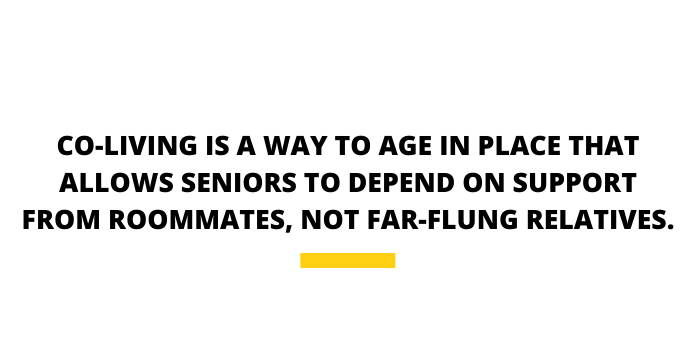
Mazeau grew up surrounded by co-living: two houses on her street were shared by groups of aging siblings; her family took in a Ugandan exchange student when she was in high school; and she lived with roommates both during university and after graduation. When she got married, family friends often stayed over for extended periods. After she got divorced, she and her son lived in four different shared households together, most with other children. “My son was spared the fate of being a spoiled only child,” she says. “The overall experience made him a tolerant and socially well-adjusted adult.”
After her son moved out, Mazeau continued living with another woman and her elderly mother in Caledon, Ontario, helping with household chores and eventually caregiving for her eldest roommate. She once accompanied the mother to a 60-year nursing-school reunion, where people assumed she was a personal-service worker or volunteer. “No,” she told them. “Actually, we’re friends.”
With both Mazeau and her daughter around, the woman was able to stay in her home until two weeks before she died. Seven years later, in January 2019, Mazeau moved out—into another shared household, of course—but she and the daughter still regularly get together to catch up.

No matter the benefits of co-living, sharing a kitchen and living room isn’t for everyone. For those seeking a little more privacy there’s co-housing—groups of individual households that share common spaces. At WindSong, a co-housing community in Langley, B.C., residents have their own townhomes but share a colourful common corridor under a greenhouse-like glass roof. At Cohabitat in Quebec City, 42 units look out onto a grassy courtyard and playground. Similar developments are in the works in Calgary, Edmonton and Hamilton.
Terra Firma, one of Canada’s oldest co-housing communities, consists of 11 households on a single block in Ottawa (most are adjoined row houses, with a few other houses across the street or a couple doors down). Terra Firma members—who range from toddlers to octogenarians—own their homes outright and pay monthly fees for common activities and elements, like a sprawling shared backyard behind the connected row houses where they host Canada Day brunches and haunted Halloween walks.
When founding member Steve Fick helped establish Terra Firma a quarter-century ago, he was craving a community of neighbours who shared their lives and looked out for one another. “It’s the way human beings used to live,” he says. “I think in our DNA we need it, but we don’t know we need it.”
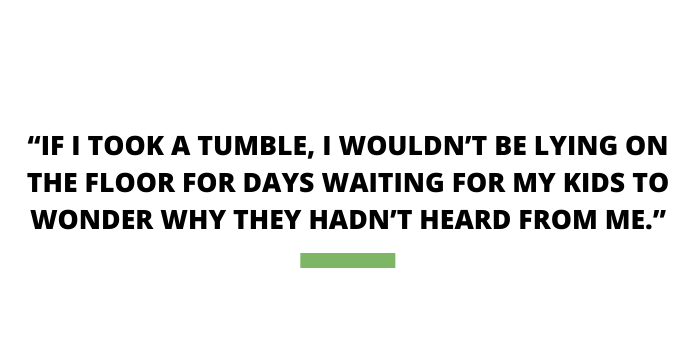
He also knew Terra Firma would be a great place to grow old. At 70, Fick and Terra Firma’s other founding members, all of whom still live in the community, are now reaping the benefits of creating a community where members care for one another by design. “During the pandemic, the younger people, including my kids, have stepped up to buy and deliver food to older people who were in isolation,” says Fick, whose two adult daughters are members of Terra Firma. “If anybody asks for help, they often get multiple offers.”
Terra Firma’s members have discussed the idea of sharing the cost of a communal support worker when the need arises. So far, they’ve managed to take care of their own. When a senior in the community developed tuberculosis, members rallied around her. They found a house on their street in which she could isolate, furnished it, brought her meals and checked in on her regularly during her time in quarantine. “I’ve seen many times when someone was in crisis and the community took care of them,” says Fick. “It made me realize that this is exactly what they would do for me, too. That is a huge sense of comfort.”
After five years of living together, the Golden Girls of Port Perry—all but one of them now in their 70s—are still healthy. But they’ve already planned for a time when they won’t be. When they renovated their house, they installed an elevator, a wheelchair-accessible entrance and a guest suite for a live-in caretaker. “We don’t know what our lives are going to look like five years down the road,” says Brown. “It’s nice to know that there are other people around. If I took a tumble down the stairs, I wouldn’t be lying on the floor for three days waiting for my kids to figure out that they hadn’t heard from Mom.”
Beyond the companionship, Bardswich says the biggest benefit of her unique living situation is retaining control of her own aging. “It’s about protecting my family so they don’t feel guilty and say, ‘God, nobody’s visited Mom at the old-age home in a while,’” she says. “They don’t need to worry about me.”
Tips for Aging Together
Aging in place is easier with others. Here’s how to make it work.
- Find the right people. Before you co-buy a house or rent a room, figure out how you live and what you want from a housemate. Consider your attitude toward cleanliness, pets, smoking, guests and other aspects of daily life. Meet potential housemates multiple times, first virtually and then in person, to communicate your expectations and see if you get along.
- Find the right property. Location is paramount. Are your needs—public transit, your doctor, a grocery store—nearby? In the ideal shared home, each resident has their own private bedroom (and bathroom, if possible) while sharing common areas like the kitchen and living room.
- Find the right groove. Before you move in, lay out house rules and everyone’s financial obligations in a legal agreement. This document should also stipulate how someone can leave, or be removed from, the house. When conflicts arise, deal with them quickly and kindly so they don’t fester or build resentment.
Next, find out how these Kingston, Ontario seniors are forming their own retirement communities.
Last spring, it dawned on my husband, Bill, and me that we were about to begin a new phase of our lives. Not only was our youngest daughter Kelly off to the University of Ottawa in September, our son, Joel, was getting married at Thanksgiving. Our oldest daughter Katelyn had recently bought a house and was beginning her apprenticeship to become an industrial electrician and our daughter Kimmy would be entering her third year at Queens University to become a teacher. We were about to become empty-nesters!
Now was our chance to focus just on us. So with the blessing of the children, we devised a plan to sell our house in Paris, Ontario, quit our jobs and buy seven acres on the Atlantic coast in one of the most beautiful places in Canada. So, the day after our son married our amazing daughter-in-law, Shailyn, at her family-owned campground on beautiful Singleton Lake north of Kingston, we were off to Sheet Harbour Passage on the Eastern Shore of Nova Scotia.

I won’t mention the tears, hurdles and many answered prayers that got us to this point, but our new journey has exceeded our expectations. We have so much to be thankful for here—the most wonderful neighbours imaginable, (thank you Ronnie and Elva and Karen and Randall for welcoming us); the fellowship of the local Baptist church; the help we received from Gammon’s hardware store, Wilson’s gas bar and the ladies at the post office; and many others who made us feel at home. Let’s not forget the stunning beauty of the Eastern Shore with the eagles, deer and opportunity to fish off the rocks for mackerel and trout.

Now the work begins to stay “mostly retired” as we set up rental accommodations with the help of my cousin Tim, owner of Nova Tiny Homes.
Don’t worry, Bill and I will still find time to kayak out to the surrounding islands and have our new friends over for game nights, campfires and to enjoy a craft beer or two brewed locally at Sober Island Brewing company.
This country has been through so much the last couple of years and if anyone needs to find some solace, we can’t think of a more perfect spot than among the proud people of Sheet Harbour Passage, Nova Scotia.
Check out more stunning pictures of Nova Scotia that may convince you to pack your bags.

My Broughton Archipelago Adventure
I sat up in my sleeping bag and strained to hear it. In the misty morning calm, I heard it again, the huff of a humpback whale. Scrambling out of my tent, finding my footing with bleary eyes I clamoured over the rocks to the water’s edge just in time to see a humpback cruising by, mere feet away. It was exhilarating! My first time seeing a whale up close. I’ve come to know that each time seeing one is just as exhilarating as the first time.

A Humpback Highway
A group of us were camped on the shore of B.C.’s Flower Island in Broughton Archipelago Provincial Park on a seven-day Level-2 Paddle Canada sea kayaking course. These islands have been utilized by First Nation peoples for generations. Flower Island is situated along Blackfish Sound, seemingly a humpback highway that week. We were lucky to witness humpbacks breaching and feeding with frequency, although not as close by as on that first day. The week was full of course content, practical knowledge and skills to go over, my head was crammed with paddle strokes, rescues, towing, weather knowledge, currents, tides, navigation and charts. As rigorous as the schedule was, it was also about discovery and exploring this beautiful area and its history and rich cultural heritage.
Using Flower Island as our base camp, we explored the channels and islands surrounding it. On the north side of Berry Island, we located the faint orange of the well-known petroglyph called Baxbakwalanuxsiwae—the Cannibal at the North End of the World. To the right of it, along the bottom of the sheer cliff wall you will see a rock formation known as the “Chief’s Bathtub,” a natural rock basin that fills at high tide. According to folklore, the local chief would bathe in this rock basin in water warmed with hot stones taken from a nearby fire.
Discover more hidden gems in B.C.

A Glimpse of Glamping
After a day spent paddling, I wished I could sit in such a hot tub as well. Cruelly, one could be seen from our campsite on adjacent Swanson Island. A big beautiful, wood-heated tub, part of Spirit of the West Adventures kayaking-glamping experience. I was resigned to tough it out—sitting on the grassy bluff of Flower Island watching the whales and sunsets, sipping on a glass of wine would just have to do.

Echoes of the Past
Mound Island would have been our other camp spot choice. The white midden beaches containing crushed clam shells show remnants of the dwellings of the First Nations who had lived here. The narrow channel between Mound Island and Harbledown Island was a good place to trap fish in the rising tide. Closing my eyes and facing the sun, I could imagine the bustle of the village at that time. Working together to forage, gather, cook, preserve and sustain the resources available.
Another day’s paddle took us down Village Channel to Village Island. Last inhabited in the 1960s, its village and surrounding territory belong to the Mamalilikulla First Nations people. Although not currently occupied by residents, it is a sacred land site to its people and is in the process of ongoing stewardship and revitalization, not only for ecotourism and cultural tours, but for the young First Nations that have never had an opportunity to visit their ancestral lands.

Reflections on a Devastating Day
It is an area rich in history. It is the site of the infamous potlatch raid. On Christmas Day 1921, a grand potlatch was in progress and was stopped by the police. Twenty-two people out of the 45 were arrested for the no-potlatch law implemented at that time. Precious potlatch ceremonial items were confiscated and handled in such a way that was abhorrent to the Mamalilikulla people. I think about how devastating that day must have been for them as I hover in the inch of water above muddy flats on an outgoing tide, unable to paddle much closer. The view from my kayak only allows me to see the tops of a few buildings from behind an overgrown hedge and an impressive wooden beam I assume is the old entrance to a longhouse. I badly want to go ashore and see it up close, but we did not call ahead to get permission or pay the fee to do so.
Many, but not all, of the artifacts have been returned to the Mamalilikulla First Nation. Some of those artifacts are on display at the Nuyumbalees Cultural Centre and Museum in Cape Mudge on Quadra Island.
Our last day’s paddle took us back across the Johnstone Strait to Telegraph Cove from where we’d launched seven days ago. In the span of a few nautical miles, we observed so much history, culture and wildlife, not to mention hauntingly beautiful scenery. We were students of sea kayaking—but also of this amazing place, the Broughton Archipelago.
Next, check out this intrepid paddler’s canoe adventure through eastern Ontario’s backcountry.
I remember the exact moment when I decided that I would never go back to my family’s cottage ever again. It was August 2000. I was 16 and sick of our annual trips from Toronto to the dusty, drafty old place in Quebec’s Laurentian Mountains.
My grandfather was also getting to me. In my mind, he ran the place like a boot camp, setting out a strict daily regimen for me, my brother and our cousins. Between 6:00 and 7:00 a.m., we had to be out of bed and in the frigid lake for our pre-breakfast swims. Then, after choking back flavourless bowls of porridge, we played tennis, swam some more and did chores.
In the afternoons, as the adults had tea or cocktails, we were expected to sit silently and listen to their tedious chit-chat. We didn’t have cable TV.
We had to be in bed by 10:00 p.m. That might not sound rough, but to my 16-year-old self, it was torture.
Right before going up that year, I had seen a documentary about ritzy Palm Beach, Florida. It confirmed my suspicions that there were better places to spend a vacation. I was so dazzled that, one morning, post polar-bear dip, I cheekily announced to my grandfather that someday soon I would visit Palm Beach (with what money, I can’t say). I wanted to know how it felt to swim in warm water. I didn’t mean it as a direct, outright rejection of the cottage, but he took it as such. He scolded me for being rude. I’d betrayed a deep and offensive ingratitude for the beauty all around me.
I took his words as a challenge. Instead of coming back to the cottage, I promised myself I would explore the world, be my own person. The next summer was the first time in my life that I didn’t make the trek.
House History
My great-grandmother and her sister bought the cottage property in 1947 as a country escape from their home in Montreal. My great-grandfather had recently returned from the war minus a hand, and they wanted a place to relax and recover. The cottage was a turn-of-the-century house with a wraparound verandah, sash windows and a giant stone hearth.
My grandfather was a teenager when he started going up there. He was naturally self-disciplined, and I imagine him loving the early morning ice swims, a routine started by his father. I can also imagine him as the kind of teen who sincerely enjoyed eating porridge and doing chores. I don’t think he ever missed a single summer until he became too frail to travel, in his mid-80s.
During all of that time, very little changed at the cottage. As recently as the early 1990s, I can remember drawing our drinking water from an old wooden well in the forest behind the house. I had to attach a plastic pail to a metal chain and hand crank it into the ground. For a long time, the most up-to-date thing about the property was the small cedar bunkhouse that my grandfather built in the 1960s. Like the main house, it wasn’t winterized. But unlike the main house, it had post-war furniture and modern, if miniature, appliances. Tucked into the trees, it had a big window that framed a stunning view of the lake.
While my grandfather was always authoritarian, my grandmother radiated warmth. And the little cedar cabin was where she made a point of spoiling her grandkids. When my grandfather was out doing chores, she served Cap’n Crunch and Froot Loops—oatmeal be damned. Instead of asking us to rake the driveway, she’d read us books and lead us in crafts. As a signal that it was a good time to come over, she would hang a red towel over the cabin’s railing. My grandfather knew, of course, and didn’t approve. But my grandmother did it anyway. She was subversive in the name of sweetness, and I loved her for that.
Homecoming
When I was 25, I cycled from Toronto to Montreal as a fundraiser for the Toronto People with AIDS Foundation. When I arrived, in early August, the city felt roasting hot and I had booked an unairconditioned hostel room for myself and my boyfriend, who is also named Matthew. I suggested we escape the humidity by spending a few days at my family cottage, where I hadn’t been since I was a teenager. He had no idea what cottage I was talking about—even though we had been together for five years.
Driving up, I realized how many things in that seemingly immutable place had changed. The big old house had been given to an uncle, who had torn it down and built something new. Although the little cabin was still there and was where my grandparents were staying, they were much older and slower moving, so my grandfather’s once-strict routine had relaxed. He even invited my opinion about politics over tea and cocktails. My grandmother simply smiled and said how nice it was that I had come.
I decided I would buy the little cabin—and keep going back forever and ever—in 2017. I was 33 and had been coming every summer for a few years. Matthew and I were out canoeing and my grandfather’s words about me not appreciating the lake’s beauty were bouncing around my brain. I had scarcely seen anywhere as pretty as the Laurentians in peak summer, with the region’s birch-covered mountainsides gently rolling up and down between the crystal clear waters of its many, many lakes. Later that year, when my uncle wanted to sell the four acres with the bunkhouse on it, I made an offer.
Now that I own it, I know first-hand how much work a cottage requires, including raking the driveway, lest the car be swallowed by a pothole. It occurs to me that my grandfather’s routine, far from silly and rigid, was probably very smart. It got things done. While 6:30 a.m. swims are out, I do happily get up early when I’m there, because mornings, when the lake is perfectly calm and shrouded in a pretty mist, are the best time to swim. And I now eat porridge every day for breakfast, having long outgrown a bowl of Froot Loops. Though I sometimes put maple syrup on my oats, just to keep things real.
Longing for your own escape? Check out the best day trips from Toronto.
Herbs and spices have the ability to take your taste buds around the world. Just by changing the flavourings, you can transform your recipes from ordinary to exotic. Though herbs and spices have been around for hundreds of years, the science to support the health benefits they afford is more recent. Still, various cultures have long recognized that these seasonings provide more than just flavour to food.
Flavour is even more essential when you are trying to reduce dietary fat and salt. (Many health experts suggest we cut down on the amount of salt in our food as a way of preventing high blood pressure and other conditions that can affect the heart.) Adding herbs and spices to recipes adds great flavour without increasing the amount of fat you consume—and without tacking on a significant number of calories. Plus, it’s a tasty way to reduce the amount of salt or sodium that you normally use in cooking. (Learn to spot the signs you’re eating too much salt.)
What’s the Difference Between Herbs and Spices?
Herbs and spices are often defined as those parts of the plant used in the diet for their aromatic properties. The difference between the two is which part of the plant each comes from. Herbs (for example, basil and thyme) are the leaf of the plant. Spices are the plant’s buds, bark, roots and seeds (for example, cloves, cinnamon, ginger and coriander, respectively).
Fresh herbs make food taste like summer, whereas dried herbs have a wintry taste. Fresh leafy herbs are usually added at the end of cooking. And since their flavour is delicate, use lots.
When using dried herbs, however, be prudent—their flavours are concentrated. Add them at the start of cooking, to reconstitute them.
Tips For Buying and Storing Herbs and Spices
When buying fresh herbs, choose those that are bright in colour, with no signs of wilting or browning. The stalks should be crisp and the leaves should not be dried out, nor should they have yellow, brown or black spots.
Fresh herbs should have a clean, fresh fragrance. It’s best to buy them close to the time that you plan to use them.
Wash the herbs under cool running water; then pat them dry, wrap them in tea towels and store them in the refrigerator in sealed containers or plastic bags. Once washed and patted dry, they can also be frozen in freezer bags.
Spices (almost always dried) lose much of their flavour within a year of being ground, so buy them in small quantities and replace them every year or two. For spices such as pepper and nutmeg, it makes a big difference to grind them as you need them, so be sure to have a good pepper grinder. A rasp works very well if you buy whole nutmeg.
Store spices and dried herbs in airtight containers, and place these in a cool, dry, dark place, away from light and heat.
Now that you know the difference between herbs and spices, find out the 20 foods you should never store in the fridge.
It’s easy to forget how dependent we are on our phones—until we can’t access them, that is. There are few things more sickening than hearing a splash as you lean over to turn off the tap of a filling tub, or even worse, fumble with your beach bag on the dock. Provided you can salvage your phone from the watery depths, all is not lost. Follow these step-by-step instructions on how to dry out a cellphone and you should be back in business in no time.
Step One: Remove the Battery
Seriously, remove the battery. “I know it’s tempting, but resist the urge to power up your phone to see if it works—just turning it on can short out the circuits,” says Joel Johnson of popularmechanics.com. Take out the SIM card, too—it may retain data, such as contacts, even if the phone itself is fried.
Step Two: Shorten the Drying Time
If the phone stays wet for too long, it will start to corrode. Skip the hair dryer; it’s too hot for this purpose and the air could force moisture deeper into the phone. A better choice is a can of compressed air or a wet-dry vacuum, if you have one.
Step Three: Sop Up Remaining Moisture
Submerge the phone in uncooked white rice for at least 12 hours. If you don’t have rice handy, place the phone on paper towels, then put it in the freezer for 15 to 20 minutes. Replace the battery and turn it on. If nothing happens, remove the battery and stick the mobile back in the freezer for another five to 10 minutes. There’s a good chance you’ll be back in communication after a couple of tries.
Now that you know how to dry out a cellphone, find out how to save your laptop after a spill.





